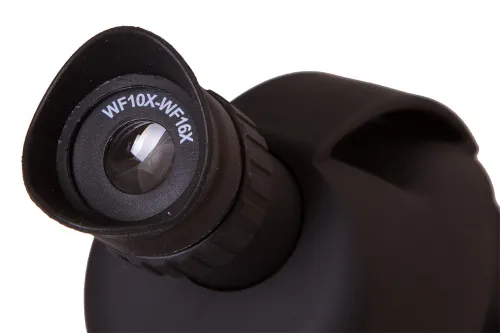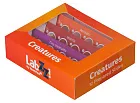Bresser National Geographic 40–640x Microscope with smartphone adapter
Microscope for kids. Experiment kit included. For studying samples in transmitted light. Magnification: 40–640х
| Product ID | 69364 |
| Brand | Bresser GmbH, Germany |
| Warranty | 2 years |
| EAN | 4007922032733 |
| Package size (LxWxH) | 28x17x15 cm |
| Shipping Weight | 0.92 kg |
Bresser National Geographic 40–640x Microscope is made specifically for young explorers. The microscope is equipped with a revolving nosepiece, and by rotating it, you can switch between three fixed magnifications in the 40–640x range. The lower LED illumination powered by batteries (included in the kit) is used for studying samples in transmitted light.
A smartphone adapter allows your little scientists to make exclusive photos and videos of their observation results! The assembly process is very easy – install the adapter on the eyepiece of your optical instrument, and then install your smartphone onto the adapter. All you have to do is turn on the smartphone camera, center it, and adjust the focus of your optical device to get clear and sharp views of observed objects. Now you can take pictures, record videos and share it with your friends!
Bresser National Geographic 40–640x Microscope comes with an interesting experiment kit. A kid will be able to observe ready-to-use microscope slides and watch Artemia’s growth in a hatchery. The kit also includes special tools for independent preparation of microscope samples. Kids can manage the instrument independently and explore amazing structures of everyday things.
Features:
- Magnification up to 640x
- LED illumination
- Battery operation makes outdoor use possible
- Extensive range of included accessories
- Smartphone adapter
- Experiment kit included
The kit includes:
- Objectives: 4x, 10x and 40x
- Eyepiece: WF10x–WF16x
- Bresser Junior 40–640x Microscope
- 3 ready-to-use specimens
- Flask with yeast
- Flask with brine shrimp
- 8 blank slides
- 8 cover slips
- Hatchery for Artemia (brine shrimp)
- Flasks
- Microtome
- Forceps
- Dropper
- Loupe
- Measuring cup
- Smartphone adapter
- 2 AA batteries
- User manual
| Product ID | 69364 |
| Brand | Bresser GmbH, Germany |
| Warranty | 2 years |
| EAN | 4007922032733 |
| Package size (LxWxH) | 28x17x15 cm |
| Shipping Weight | 0.92 kg |
| Type | biological, light/optical |
| Microscope head type | monocular |
| Magnification, x | 40 — 640 |
| Eyepieces | WF10x–16x (two-position) |
| Objectives | 4x, 10x, 40x |
| Revolving nosepiece | for 3 objectives |
| Focus | coarse |
| Illumination | LED |
| Brightness adjustment | ✓ |
| Power supply | 2 AA batteries |
| Power supply: batteries/built-in battery | 2 AA batteries (Mignon), 1.5V |
| Light filters | yes, diaphragm disc |
| User level | elementary |
| Application | elementary, school/educational |
| Illumination location | lower |
| Research method | bright field |
| Experiment kit included | ✓ |
and downloads
We have gathered answers to the most frequently asked questions to help you sort things out
Find out why studying eyes under a microscope is entertaining; how insects’ and arachnids’ eyes differ and what the best way is to observe such an interesting specimen
Read this review to learn how to observe human hair, what different hair looks like under a microscope and what magnification is required for observations
Learn what a numerical aperture is and how to choose a suitable objective lens for your microscope here
Learn what a spider looks like under microscope, when the best time is to take photos of it, how to study it properly at magnification and more interesting facts about observing insects and arachnids
This review for beginner explorers of the micro world introduces you to the optical, illuminating and mechanical parts of a microscope and their functions
Short article about Paramecium caudatum - a microorganism that is interesting to observe through any microscope
















